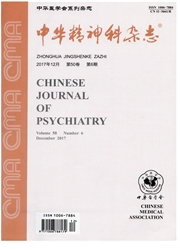

 中文摘要:
中文摘要:
目的利用功能磁共振成像(fMRI)技术,探讨在创伤后应激障碍(PTSD)患者的陈述性记忆损害中是否存在岛叶结构及功能异常。方法应用基于体素的形态测量学和汉字编码任务,对12例PTSD患者(PTSD组)和12名正常对照者(对照组)进行脑结构和fMRI扫描,比较两组间岛叶结构及功能的差异。结果(1)PTSD患者双侧岛叶的灰质密度(右侧岛叶x=34,y=4,z=6,t=4.44;左侧岛叶x=-36,y=2,z=0;t=4.64)低于对照组;(2)在编码作业时,左侧岛叶的激活程度(x=-40,y=-20,z=14)亦低于对照组(P均〈0.05)。结论PTSD患者的岛叶存在结构损害,并在陈述性记忆作业中呈现功能异常,提示岛叶结构的损害可能与PTSD的陈述性记忆损害有关。
 英文摘要:
英文摘要:
Objective To explore the relation between insular and the deficits of declarative memory in patients with posttraumatic stress disorder. Methods The VBM and the encoding task were performed in 12 patients with PTSD and 12 normal controls by using structural MRI and function MRI, then the differences of insular structure and function between PTSD patients and controls were compared. Results In structure, regions with less gray-matter density in PTSD group compared with control group included bilateral insulars ( Brodmann's area 13 ) [ left insular, peak coordinate (Talairach) , (x = - 36, y = 2, z = 0), t=4.64; right insular, (x=34, y=4, z=6), t=4.44], lefthippocampus(x= -26, y= -13, z= -17; t=5.05) and left anteriorcingulate cortex (Brodmann's area 32) (x= -2, y=40, z=17; t= 5.05 ). In comparison with the control group, PTSD patients had significantly lower level of BOLD signals in the insular ( Z = 2. 17, P 〈 0. 05 ). Conclusion The pathological abnormality might exist in the insular in patients with PTSD, and it might relate to the deficits of declarative memory.
 同期刊论文项目
同期刊论文项目
 同项目期刊论文
同项目期刊论文
 Insular cortex involvement in declarative memory deficits in patients with post-traumatic stress dis
Insular cortex involvement in declarative memory deficits in patients with post-traumatic stress dis Effects of serotonin depletion on the hippocampal GR/MR and BDNF expression during the stress adapta
Effects of serotonin depletion on the hippocampal GR/MR and BDNF expression during the stress adapta Brain responses to symptom provocation and trauma-related short-term memory recall in coal mining ac
Brain responses to symptom provocation and trauma-related short-term memory recall in coal mining ac Subsequently enhanced cpp to morphine following chronic but not acute footshock stress associated wi
Subsequently enhanced cpp to morphine following chronic but not acute footshock stress associated wi Lower levels of whole blood serotonin in obsessive-compulsive disorder and in schizophrenia with obs
Lower levels of whole blood serotonin in obsessive-compulsive disorder and in schizophrenia with obs 期刊信息
期刊信息
